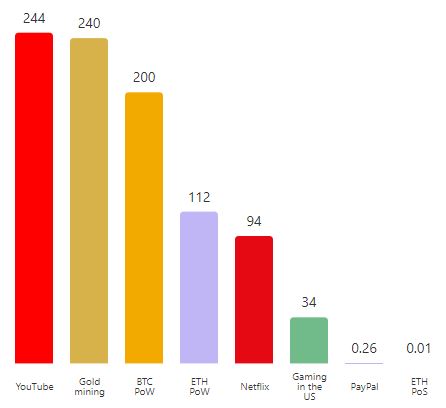Key Takeaways
- NFTs have faced major criticism concerning their impact on the environment.
- Much of the criticism is rooted in a misunderstanding about how blockchains function.
- The major Layer 1 blockchains that serve as the main hubs for NFTs consume less energy than detractors seem to think.
Share this article
Ethereum cut its energy consumption by 99.95% when it completed the Merge, meaning NFTs are more environmentally-friendly than ever. But did the ecological backlash against digital collectibles even make sense in the first place?
NFT Hype and Backlash
Is crypto art destroying the planet? Not as much as its naysayers would have you believe, it turns out.
A new cultural phenomenon gripped the world in 2021. A generation of digital artists found a way to monetize their work on the blockchain through NFTs, leading the most sought-after pieces to sell for eye-watering sums. Beeple made global headlines in March when he sold an NFT for $69 million at Christie’s. Avatar-based NFT collections like Bored Ape Yacht Club also soared in popularity. Bored Apes launched in April and were adopted by celebrities such as Paris Hilton, Jimmy Fallon, and Snoop Dogg; a year later their floor price peaked at around $435,000.
Most NFTs to emerge during the 2021 boom were minted on Ethereum when it was using Proof-of-Work, a famously energy-intensive consensus mechanism that also secures Bitcoin. This prompted a backlash from certain mainstream media outlets and crypto outsiders as they began to question the technology’s environmental impact. Critics decried NFTs as carbon-intensive Ponzi schemes on social media, slamming any artists and collectors who endorsed the technology.
While concerns over the environmental impact of any new technology are valid, much of the criticism directed toward NFTs is based on misconceptions of how blockchains work. So, how much energy do NFTs actually consume? The hard data suggests that it’s less than many critics seem to think.
How Blockchains Work
The most common misconception surrounding NFTs and their environmental impact concerns the carbon footprint of making a blockchain transaction. Many believe that transactions cost a certain amount of energy, but they don’t.
Blockchains are cryptographic accounts or ledgers. These ledgers keep a record of all of the transactions on the network in blocks. New blocks are created at regular intervals to update the ledgers with new transactions. Bitcoin creates a new block roughly every 10 minutes, while Ethereum does every 10 to 20 seconds.
Blockchain networks are secured by service providers. Proof-of-Work blockchains like Bitcoin rely on miners, while Proof-of-Stake blockchains like Ethereum rely on validators. Miners and validators are responsible for adding new blocks to the chain at a constant rate. Miners need to power specialized hardware and validators also need equipment to contribute to their respective networks. While both consume energy, mining is much more energy intensive.
The amount of energy block producers consume does not depend on the level of activity on the network. Whether there are no transactions or thousands in a given period, blocks get produced at the same rate. In fact, blocks frequently get added to the chain with plenty of space left.
Adding an empty block to the chain requires the same amount of energy as a block filled with NFT mints. In crypto, the entire network consumes energy —not individual transactions. Using the network to mint an NFT has zero impact on the blockchain’s ecological footprint.
Demystifying Gas Prices
Are there any consequences to taking up block space? Yes, but not in terms of energy consumption. On Ethereum, for example, users pay for block space in gwei; one gwei is worth one-billionth of 1 ETH. These are the “gas prices” crypto natives refer to when speaking of transaction fees.
Buying, selling, or sending NFTs uses the same amount of gas as transacting any other kind of cryptocurrency. While NFTs may take the form of digital art, music, or domain names, they live on the network as tokens. Sending an NFT doesn’t take up any more block space than sending any other type of token.
With that said, minting an NFT requires significant block space. Some highly-anticipated mints have led to huge spikes in gas prices due to network congestion from NFT fans simultaneously fighting for block space. Otherside, the Metaverse world project from Bored Ape Yacht Club creator Yuga Labs, cost minters more than $150 million in gas fees on its virtual land NFT drop in April.
But while complex operations like NFT minting can have higher transaction fees, they do not make blockchains consume more energy. Gas price is the only shifting variable; energy usage doesn’t change even if the price does.
Ethereum’s Energy Usage
Ethereum is the world’s largest smart contract platform. It was the focal point of the NFT boom in 2021, hosting famous collections like Bored Ape Yacht Club, CryptoPunks, and Fidenza. The biggest NFT marketplace, OpenSea, launched with support for Ethereum before expanding to other networks. As Ethereum is effectively the home of NFTs, it’s important to consider its energy consumption to understand how much NFTs impact the environment.
During its first seven years, Ethereum used a Proof-of-Work consensus mechanism like Bitcoin, which helped NFTs get a bad reputation early on. According to the Ethereum Foundation, the network’s electricity use peaked at 94 TWh per year when it ran Proof-of-Work, which is slightly more than the energy consumption of Bolivia.
While Ethereum’s energy use climbed from 2021 through early 2022, it dropped around 99.95% when the network completed “the Merge” to Proof-of-Stake on September 15. That’s because the network stopped relying on miners to produce blocks. According to the Ethereum Foundation, the network now uses around 0.01 TWh per year.

After the transition to Proof-of-Stake, Ethereum now uses less energy than many services used by everyday people, such as PayPal, Netflix, and YouTube. As the Ethereum Foundation puts it, “estimates imply that people consumed 45 times more energy watching Gangnam Style in 2019 than Proof-of-Stake Ethereum uses in a year.”
Furthermore, Ethereum is fostering an active regenerative finance community that aims to build decentralized finance protocols that positively impact ecological matters. Ethereum has dropped its high energy consumption and is slowly becoming a socially and environmentally-friendly technology.
NFTs on Other Blockchains
While Ethereum is the main hub for NFTs, it is not the only network that hosts them. Other blockchains such as Solana, Tezos, Polygon, and BNB Chain have all fostered relatively robust NFT communities. None of these networks uses Proof-of-Work.
Solana’s September 2022 energy use report states that the blockchain consumes about 4,056,273,936 Joules per hour. That’s the equivalent of 9.87 KWh (or just under 0.01 TWh) per year, slightly less than Ethereum now uses.
Tezos is more energy efficient than Ethereum and Solana, using an estimated 0.001 TWh annually, per Tezos estimates. The Proof-of-Stake network has branded itself as a “green” blockchain, inspiring many environmentally-conscious crypto artists to mint their work on the network.
Polygon is an Ethereum scaling solution that hosts its own NFTs and is supported on OpenSea. 2021 estimates from the Polygon team put the network’s energy consumption at about 0.00079 TWh yearly, and the blockchain has more recently committed to going carbon negative. In September 2022, Polygon stated that Ethereum’s transition to Proof-of-Stake would cut the scaling solution’s carbon footprint by 99.91%, bringing it to 56.22 tCO2e yearly. That’s around the same level of emissions as 12 gasoline-powered cars.
While BNB Chain has not shared data on its energy consumption, it uses Proof-of-Stake like Ethereum. However, it is secured by only 21 validators, which need specialized hardware to process the chain’s enormous throughput. BNB Chain likely uses a similar amount of energy to its Layer 1 competitors, if not more.
Final Thoughts
Energy consumption is a complex and nuanced subject. Even Proof-of-Work blockchains like Bitcoin can be environmentally-friendly; it depends on the energy sources they use. Miners that use solar, thermal, hydro, or nuclear energy, for instance, can be considered more environmentally friendly than those that use fossil fuels. As Bitcoin advocate Nic Carter has tirelessly argued, crypto mining is a much greener industry than critics let on.
It’s also worth mentioning that criticisms over energy usage tend to be selective. YouTube consumes more electricity than Bitcoin, but it doesn’t face as much pressure to go green. NFTs have received harsh treatment from major news outlets and skeptics, but the tides may shift if more people start to learn about Proof-of-Stake or engage with the technology.
In any case, NFT collectors don’t have to worry about the environmental impact of their on-chain activity. Transactions don’t increase energy consumption; that’s simply not how blockchains work. Most importantly, networks like Ethereum, Solana, and Tezos have very low energy usage. In other words, mint away.
Disclaimer: At the time of writing, the author of this piece owned BTC, ETH, and several other cryptocurrencies.
Share this article
Read More: cryptobriefing.com









 Bitcoin
Bitcoin  Ethereum
Ethereum  XRP
XRP  Tether
Tether  Solana
Solana  Dogecoin
Dogecoin  USDC
USDC  Cardano
Cardano  Lido Staked Ether
Lido Staked Ether  TRON
TRON  Avalanche
Avalanche  Sui
Sui  Wrapped stETH
Wrapped stETH  Toncoin
Toncoin  Stellar
Stellar  Shiba Inu
Shiba Inu  Chainlink
Chainlink  Wrapped Bitcoin
Wrapped Bitcoin  Hedera
Hedera  Polkadot
Polkadot  WETH
WETH  Bitcoin Cash
Bitcoin Cash  LEO Token
LEO Token  Uniswap
Uniswap  Litecoin
Litecoin  Pepe
Pepe  Hyperliquid
Hyperliquid  Wrapped eETH
Wrapped eETH  USDS
USDS  NEAR Protocol
NEAR Protocol  Ethena USDe
Ethena USDe  Aptos
Aptos  Internet Computer
Internet Computer  Aave
Aave  Mantle
Mantle  POL (ex-MATIC)
POL (ex-MATIC)  Ethereum Classic
Ethereum Classic  Cronos
Cronos  Render
Render  MANTRA
MANTRA  Monero
Monero  Bittensor
Bittensor  Artificial Superintelligence Alliance
Artificial Superintelligence Alliance  Tokenize Xchange
Tokenize Xchange  Dai
Dai  Filecoin
Filecoin  Arbitrum
Arbitrum